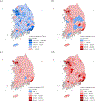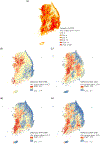Depopulation, super aging, and extreme heat events in South Korea
- PMID: 37799350
- PMCID: PMC10553378
- DOI: 10.1016/j.crm.2022.100456
Depopulation, super aging, and extreme heat events in South Korea
Abstract
South Korea's population is declining and its composition changing, associated with lowest-low fertility rates and rapid aging (super aging). When estimating changes in future exposure to extreme heat events (EHE), events that are predicted to be intensified due to climate change, it is important to incorporate demographic dynamics. We analyze business-as-usual (BAU) population and climate scenarios-where BAU refers to no significant change in current processes and trends in either domain-from 2010 to 2060 for South Korea. Data for both BAU scenarios are spatially linked and used to measure and identify national and sub-national and age-group specific EHE exposure. The results reveal an increasing exposure to EHE over time at the national level, but this varies widely within the country, measured at the municipal level. The most intensive exposure levels will be in the decade ending in 2040 driven by high estimated severe EHE. Sub-nationally, Seoul will be the most vulnerable municipality associated with super aging, while severe EHE not demographic factors will be relevant in Daegu, the second-most vulnerable metropolitan area. By 2060, national estimates suggest the older population will be up to four times more exposed to EHE than today. While the population of South Korea will decline, the rapid aging of the population ensures that specific regions of the country will become exceedingly vulnerable to EHE.
Keywords: Business-as-usual population; Climate change; Extreme heat events; Population aging; Population dynamics; climate scenarios.
Figures











Similar articles
-
Global fertility in 204 countries and territories, 1950-2021, with forecasts to 2100: a comprehensive demographic analysis for the Global Burden of Disease Study 2021.Lancet. 2024 May 18;403(10440):2057-2099. doi: 10.1016/S0140-6736(24)00550-6. Epub 2024 Mar 20. Lancet. 2024. PMID: 38521087 Free PMC article.
-
Super Aging in South Korea Unstoppable but Mitigatable: A Sub-National Scale Population Projection for Best Policy Planning.Spat Demogr. 2020 Jul;8(2):155-173. doi: 10.1007/s40980-020-00061-8. Epub 2020 Jun 12. Spat Demogr. 2020. PMID: 34222615 Free PMC article.
-
South Korea's low fertility raises European-style issues.Popul Today. 1991 Oct;19(10):3. Popul Today. 1991. PMID: 12284303
-
The 2023 Latin America report of the Lancet Countdown on health and climate change: the imperative for health-centred climate-resilient development.Lancet Reg Health Am. 2024 Apr 23;33:100746. doi: 10.1016/j.lana.2024.100746. eCollection 2024 May. Lancet Reg Health Am. 2024. PMID: 38800647 Free PMC article. Review.
-
Indoor overheating: A review of vulnerabilities, causes, and strategies to prevent adverse human health outcomes during extreme heat events.Temperature (Austin). 2024 Jun 4;11(3):203-246. doi: 10.1080/23328940.2024.2361223. eCollection 2024. Temperature (Austin). 2024. PMID: 39193048 Free PMC article. Review.
Cited by
-
Future Blood Debt: Projecting Blood Supply and Demand of Korea Based on Subnational Population Projections (2021-2050).J Korean Med Sci. 2024 May 27;39(20):e168. doi: 10.3346/jkms.2024.39.e168. J Korean Med Sci. 2024. PMID: 38804012 Free PMC article.
References
-
- Adger W Neil. 2006. “Vulnerability.” Global Environmental Change 16 (3): 268–81. 10.1016/j.gloenvcha.2006.02.006. - DOI
-
- Basten Stuart. 2013. “Redefining ‘Old Age’ and ‘Dependency’ in East Asia: Is ‘Prospective Aging’ A More Helpful Concept?” Asian Social Work and Policy Review 7 (3): 242–48. 10.1111/aswp.12015. - DOI
-
- Cheng Jian, Xu Zhiwei, Bambrick Hilary, Su Hong, Tong Shilu, and Hu Wenbiao. 2018. “Heatwave and Elderly Mortality: An Evaluation of Death Burden and Health Costs Considering Short-Term Mortality Displacement.” Environment International 115 (April): 334–42. 10.1016/j.envint.2018.03.041. - DOI - PubMed
Grants and funding
LinkOut - more resources
Full Text Sources
